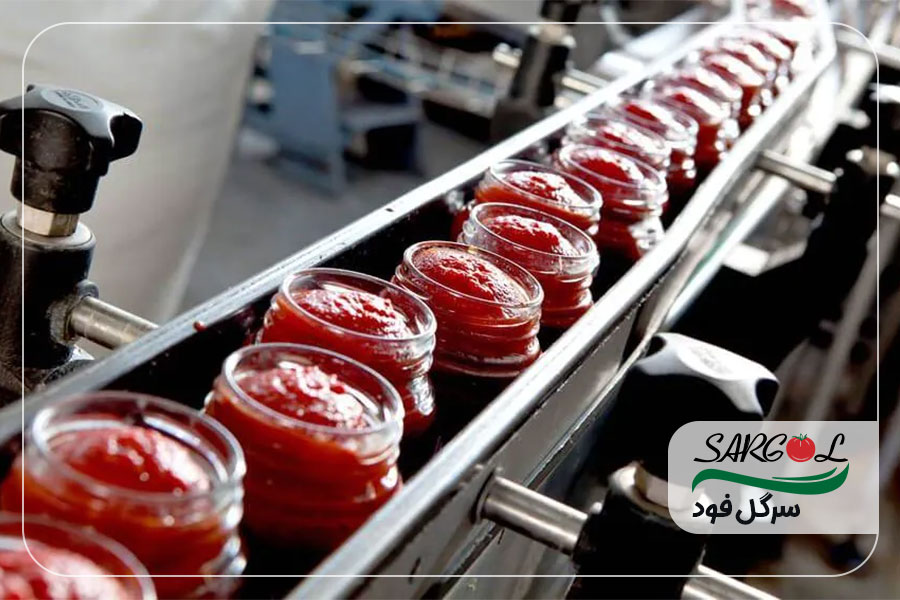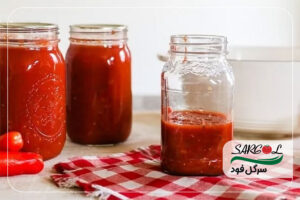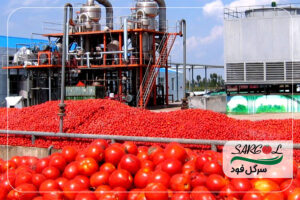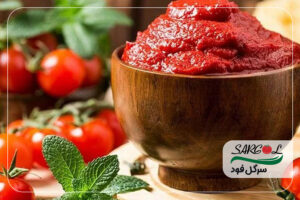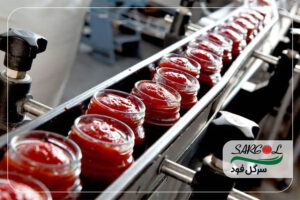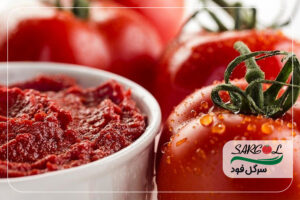Industrial tomato paste is a product obtained from the processing and concentration of tomatoes and is widely used in cooking to add flavor and color to foods. Due to its long shelf life, strong taste and easy use, this product is considered one of the most widely used ingredients in cooking.
Production stages of industrial tomato paste
Selection and washing of tomatoes: In the first stage, tomatoes are collected from the fields and transported to the factory. Then the tomatoes are washed and cleaned of any pollution, dirt and waste materials.
Crushing and Extraction: Tomatoes are crushed after washing and juice is extracted through processes such as grinding.
Filtering and straining: The tomato extract passes through a strainer to separate the seeds and skin and obtain a uniform liquid.
Condensation: The liquid obtained from the previous step is boiled at a high temperature to evaporate its excess water and increase its concentration. This step makes the tomato paste get the necessary consistency.
Adding preservatives: In some cases, preservatives or salt are added to tomato paste to increase its shelf life. Of course, this depends on the formulation and standards of each factory.
Packaging: After reaching the desired concentration, tomato paste is packed in special containers. These containers can be glass, metal cans or plastic packaging.
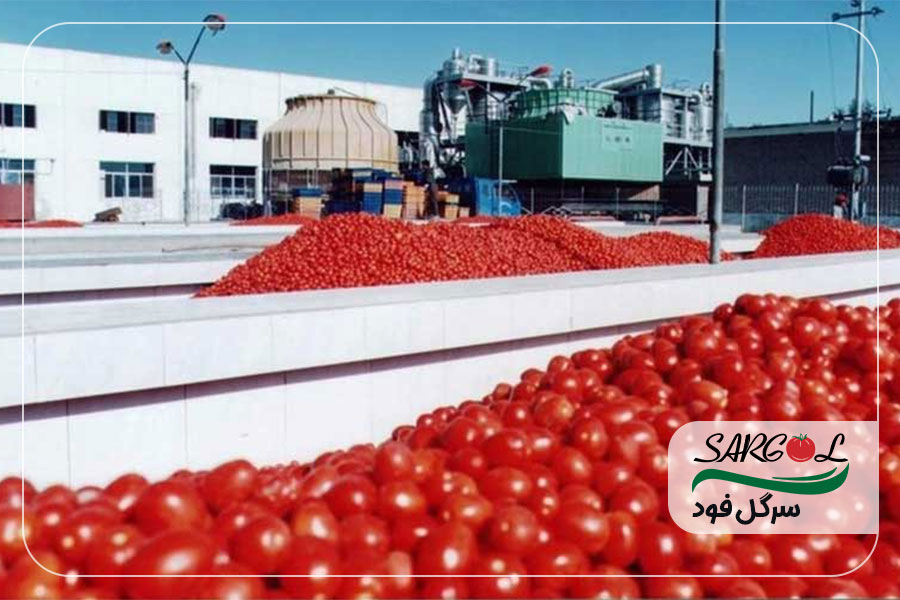
Features of industrial tomato paste
Color: High quality tomato paste should have a dark red color and uniformity.
Taste: The taste of the paste should be natural and without unusual or bitter flavors.
Concentration: proper concentration and optimal consistency are important features of a quality industrial tomato paste.
Durability: Due to thermal processes and proper packaging, industrial tomato paste can last for a long time without needing to be stored in the refrigerator.
Applications
Industrial tomato paste is used in the preparation of various foods such as soups, stews, sauces and various traditional dishes. Due to its strong taste and proper coloring, this product has a special place in cooking, especially in Iranian cooking.
Ingredients of industrial tomato paste
The main ingredients of industrial tomato paste generally include the following:
Tomatoes: The main ingredient of tomato paste is fresh tomatoes, which are turned into paste after extracting the extract and concentrating.
Salt: In some types of industrial tomato paste, some salt is added. Salt acts as both a flavoring agent and a preservative.
Preservatives: Some manufacturers may use preservatives such as sodium benzoate or potassium sorbate to increase product shelf life. However, some pastes are produced without preservatives.
Citric Acid: Citric acid (found naturally in citrus fruits) may be added as a pH adjuster and shelf life enhancer. This substance increases the acidity of the product and helps prevent the growth of unwanted microorganisms.
Optional items:
Oil: In some cases, a small amount of oil is added to improve the consistency and taste of the paste, but this is not common and depends on the specific formulation of the brand.
Sugar: In some formulations, a little sugar may be added to the paste to moderate the acidity and improve the taste, although this is usually done in homemade pastes or some special brands.
Important points:
The exact ingredients may vary depending on the brand and type of tomato paste. To ensure the quality and exact ingredients, it is better to read the label on the product. A quality tomato paste should usually contain a high percentage of tomatoes and minimal additives.
Industrial tomato paste production line
The industrial tomato paste production line is a complex and fully mechanized process that includes various steps from tomato preparation to the final packaging of the product. In the following, the main steps of this process are explained:
1. Receiving and washing tomatoes
Received: Tomatoes are transported from the fields to the factory and stored in special silos.
Washing: Tomatoes are washed with high-pressure water to remove dirt, pollution and waste materials. This step may include several washing steps to thoroughly clean the tomatoes.
2. Sorting and inspection
Sorting: Tomatoes are sorted automatically or manually based on size, color and quality. Unsuitable or damaged tomatoes are removed from the production line.
Inspection: Tomatoes are inspected for quality and health so that the final product has the desired quality.
3. Crushing
Healthy tomatoes are transferred to a crusher, where they are cut into smaller pieces to make the extraction process easier.
4. Pre-heating
Chopped tomatoes are heated by steam at a certain temperature to deactivate the existing enzymes and improve the final taste of the product.
5. Pulping
Cooked tomatoes are transferred to special machines that separate the skin, seeds and other solid parts from the tomato juice. This extract contains tomato juice, meat and soluble substances.
6. Filtration and refining
At this stage, the resulting extract is refined until it becomes completely uniform and any remaining impurities are removed from it.
7. Concentration (Evaporation)
Tomato extract is placed in condensation devices (evaporators). In these machines, the water in the extract is removed using heat under vacuum so that the extract reaches the desired concentration and becomes a paste.
8. Adding preservatives and salt (optional)
In this step, preservatives, salt or citric acid are added to the tomato paste to increase the shelf life of the product.
9. Pasteurization
After concentration, tomato paste is pasteurized to prevent the growth of harmful microorganisms and increase its shelf life.
10. Packaging
Pasteurized tomato paste is automatically transferred to packaging machines, where it is packed in glass containers, metal cans or plastic bags. The packaging containers are then sealed and prepared for the market.
11. Labeling and storage
The final packages of tomato paste are labeled with appropriate labels, including information such as production date, expiration date, and product specifications, and are then transferred to special warehouses for distribution.
This process is generally mechanized to ensure high productivity and uniform product quality.
Price of industrial tomato paste machine
The price of industrial tomato paste production line machines depends on various factors, including production capacity, level of automation, brand and country of manufacture. This equipment can be purchased as a complete production line or separately (such as washing, shredding, concentrating, pasteurizing and packaging machines).
Price range
Small and semi-industrial production lines:
These production lines have less capacity and are more suitable for workshops or small production units. Their prices usually start from several hundred million tomans.
Medium production lines:
Medium production lines have a higher capacity and can produce continuously and at a higher speed. Depending on the brand and equipment, their price can vary from several hundred million to several billion tomans.
Large and fully automatic production lines:
These production lines are designed for large industrial units and operate fully automatically. The price of these lines can be from several billion tomans.
The price of individual devices
Washing machine: about 50 to 200 million tomans.
Shredder: about 100 to 500 million tomans.
Condenser: about 300 million to 1 billion tomans or more.
Pasteurization machine: about 200 million to 800 million tomans.
Packaging machine: about 100 million to 1 billion tomans or more, depending on the type of packaging (glass, metal cans, or plastic packages).
Factors affecting the price
Brand and country of manufacture: Devices made in European countries are usually more expensive than devices made in Asian or domestic countries.
Production capacity: The higher the production capacity of the machine, the higher its price.
Level of automation: Fully automatic machines are more expensive than semi-automatic or manual machines.
For more detailed information and purchase of this equipment, you can contact the companies that produce and import these devices and ask for a price based on your production needs.

